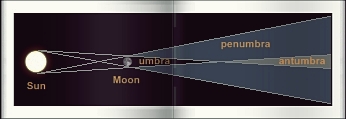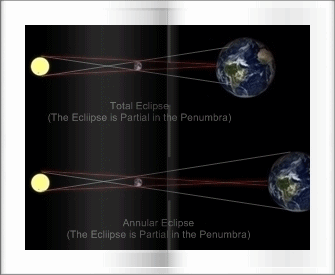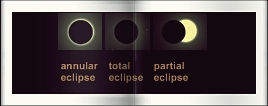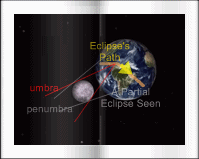
| CONTENT - All about the solar eclipses, those major astronomical phenomenon! |
| CAUTION! OBSERVING A SUN ECLIPSE IS DANGEROUS AND MAY CAUSE IRREVERSIBLE EYE DAMAGE, ANNULAR AND PARTIAL ECLIPSES INCLUDED! Observing a Sun eclipse necessitates DEDICATED SAFE TECHNIQUES! |
A solar eclipse occurs when the Moon, relatively to an observer, is screening the Sun. Although the Moon is orbiting Earth regularly, an eclipse does not occur at each time the Moon is in line, between the Sun and the Earth. The celestial mechanics makes the Moon be situated at the right place much less often. Depending on the position and the distance of the observer, any eclipse is total, annular, or partial. Is the observer, in line, sufficiently close to the Moon, the eclipse is total, that is that the observer is seeing the Moon larger than the Sun. The Sun is completely occulted. Is he, in line, further, the eclipse is annular. The observer sees the Moon smaller than the Sun. A ring of Sun is seen all around the Moon's disk. Is the observer, at any distance, shifted relative to the axis of the eclipse, he does see a partial eclipse only. A part of the solar disk is occulted only. The variation of the apparent diameter of both the Sun and the Moon, respectively, may also be considered a factor as the Sun's apparent diameter lie between 31.5' when Earth is at its perihelion, by July each year and 32.5' when at the aphelion by January. Moon may vary from 29.3' to 33.5' between its apogee and perigee. When a solar eclipse occurs few after or near a Moon perigee, that, generally, produces a long duration of totality when the trajectory of the eclipse lies near the Earth's equator

Theoretically, these situations are described as the observer being in any of three kinds of Moon's shadow, the "umbra", the "antumbra", or the "penumbra", three Latin words meaning "shadow", "anti-shadow", and "near shadow". The situations, on the other hand, may be taken at the reverse, by considering the observer in abstract no more, but the position of the Moon instead, relative to the observer, located on the Earth this time. When the observer is where the "umbra" reaches Earth, there is a total eclipse. When he is where it's the "antumbra" which hits Earth, there is an annular eclipse. In both cases, if the observer is where the "penumbra" is, he sees a partial eclipse only

Should neither the "umbra" or the "antumbra" touch Earth in any place, but the "penumbra" only, there is a partial eclipse, independently of any total or annular eclipse. The combined effects, at last, of the Moon's distance and of the curvature of the Earth may yield what is called a "hybrid", or "annular-total" eclipse. At the beginning and the end of the eclipse's journey, it's the "antumbra" which reaches Earth only, as along the eclipse, it's the "umbra" which does. The eclipse begins and ends as annular as in-between it's total. Like for a total and an annular eclipse, such hybrid eclipses are accompanied by a partial eclipse. The variation of the distance of the Moon to the Earth is due to that the Moon's orbit is not a circle but an ellipse, hence Moon's apparent diameter is seen varying. A hybrid eclipse is rare as, in most cases, the central path begins annular, changes to total for the middle portion of the track, and reverts back to annular towards the end of the path. The width of a hybrid is small
Technically, total, annular, and hybrid eclipses are "central eclipses" as the central axis of the eclipse hits the Earth, as partial eclipses only are "non-central eclipses" as the axis hits nowhere. As far as statistics are concerned, the balance is as follow as far as the different types of eclipses are concerned: total eclipses account for 26.6 percent of the total of the eclipses, annular eclipses for 32.9 percent, hybrid for 5.2 percent. Partial eclipses only account for 35.3 percent

Due to the respective motions of the Moon and the Earth, an eclipse, of whatever sort, is moving. When it's about a total or an annular eclipse -and a hybrid eclipse, the "umbra" or the "antumbra" follow what's called a "path". It's the eclipse's path, or path of the shadow, or the "central line". The eclipse's path is usually about 10,000-mile long and 100-mile wide as the eclipse umbra is moving at a speed of 1,056 mph. A large value for the gamma value of a eclipse -which is given on a eclipse's chart- usually means that the trajectory of the Moon's umbral shadow takes it to high northern latitudes where Earth's rotation makes a smaller contribution in keeping the totality up with the umbra compared to eclipses near the equator. Another effect of a large gamma eclipse is that the umbra sweeps across Earth's surface at a steep angle, producing a wide path of totality. Eclipse is most of the time moving eastwards. Eclipse's duration is rarely above several minutes. When the eclipse is total, observers are granted by a great show, the chromosphere a pink-red ring around the Sun with the corona's plasma streamers surrounding the occulted disk as both the beginning and the end of the totality are heralded by the Baily's beads -- which are light shining through gaps in the lunar terrain -- and the "diamond ring," which is seen as the last and first slither of sunlight glints through immediately before and after totality. The beads refer to the tiny pearls and droplets of sunlight that can be seen forming around the Moonís dark outline as when the Moon keeps into the eclipse, the beads draw together and form the more solid and extended band of light, or the diamond ring effect. The darkening during an annular eclipse is function of the percentage of the ring of Sun remaining surrounding the Moon's disk. The "diamond ring" phenomenon is seen during an annular eclipse too. As far as partial eclipses are concerned, the farther the line of centrality, the lesser the part of the solar disk seen occulted by the Moon and the nearer, the opposite
 |
![]() click here for a video (Windows Movie Player, .wmv format, 1.6 Mb) of the illustration of a total solar eclipse!
click here for a video (Windows Movie Player, .wmv format, 1.6 Mb) of the illustration of a total solar eclipse!
On average, a total solar eclipse occurs about every 18 months somewhere on Earth, although at any particular location, it happens much less often. There may be between 2 and 5 solar eclipses each year but there can not be more than 7 eclipses (solar, and lunar) in one given year: 4 solar eclipses and 3 lunar eclipses; or 5 solar eclipses and 2 lunar. In terms of eclipses, both solar and lunar, a 'Saros' is a period of 6,585.3 days (18 years 11 days 8 hours) by the end of which a eclipse repeats. The eclipse however is shifted by 120 degree of longitude as, every 3 saros, it occurs at the same location. Albeit the eclipses' geometry is not exactly the same, they are close enough however to allow Saros to themselves settle into series which last 12 centuries or more. During one Saros, a average of 84 eclipses are found which part evenly between 42 solar, and 42 lunar ones. Eclipses in history were subject of people's superstitional fears as they also allowed landmarks in astronomy, such as the expedition to confirm the theory of Einstein's General Relativity, the first report of coronal mass ejections, or the discovery that the corona is much hotter than the surface of the Sun. Eclipses were also instrumental, by the 19th century A.D. into furthering knowledges about the Sun. It is eclipse spectroscopy, the use of spectroscopy during a eclipse, for example, which detected helium in 1868 albeit researchers study the Sun's atmosphere continuously by replicating the effects of an eclipse using an instrument called a coronagraph, which uses a solid disk to block the Sunís bright surface, coronagraphs are less effective than natural eclipses, however. Because of how light bends around sharp edges, a phenomenon called diffraction, coronagraph disks must be much larger than would otherwise be necessary to block Sunís face, hampering the lower corona's observation. As astronomers don't need a eclipse anymore to study the corona because they can use the coronograph which blocks most of Sun's light, the innermost regions of it, in white light, keeps needing a total solar eclipse to be observed
Website Manager: G. Guichard, site 'Amateur Astronomy,' http://stars5.6te.net. Page Editor: G. Guichard. last edited: 2/15/2017. contact us at ggwebsites@outlook.com